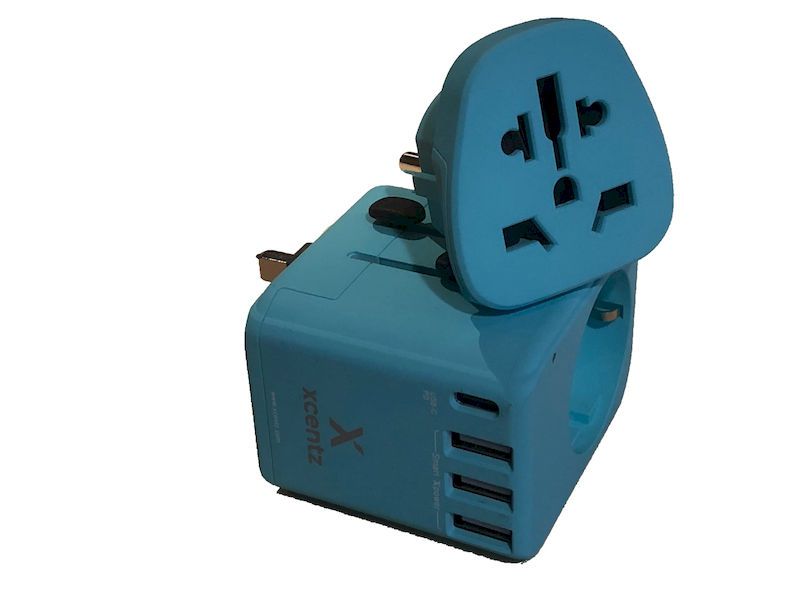 REVIEW – World travelers are exposed to different cultures, languages, food, sights, and AC power plugs and sockets. The Xcentz universal travel adapter makes dealing with different types of plugs and sockets more convenient. As a bonus, this device has three USB-A ports and a USB-C port. Read on to see what I think!
REVIEW – World travelers are exposed to different cultures, languages, food, sights, and AC power plugs and sockets. The Xcentz universal travel adapter makes dealing with different types of plugs and sockets more convenient. As a bonus, this device has three USB-A ports and a USB-C port. Read on to see what I think!
What is it?
The Xcentz universal travel adapter permits cross connecting plugs from different regions so that the pins will align and current will flow through the adapter. The adapter does not convert voltage or adjust frequency, so travelers must be cautious about using dual voltage electronics and electronics that are not sensitive to variation in AC frequency. The adapter has two parts: a type C/E/F plug that adapts to various countries, and an adaptor that plugs into various outlets, powers the three USB-A and one USB-C power adapters, and also has a type F outlet on the back. The description of the type of outlet is based on the designation provided by the IEC. The different type of plugs and the countries/geographies where the plugs are used are listed on the following table.
| Type | Country/Geography |
|---|---|
| A | North and Central America, Japan |
| B | North and Central America, Japan |
| C | Europe, with the exception of the UK, Ireland, Cyprus and Malta |
| D | India, Sri Lanka, Nepal, Namibia |
| E | France, Belgium, Slovakia, and Tunisia among others |
| F | Germany, Austria, the Netherlands, and Spain among others |
| G | UK, Ireland, Cyprus, Malta, Malaysia, Singapore, Hong Kong |
| H | Israel |
| I | Australia, New Zealand, Papua New Guinea, Argentina |
| J | Switzerland and Lichtenstein |
| K | Denmark and Greenland |
| L | Italy |
| M | South Africa, Swaziland, Lesotho |
| N | Brazil |
| O | Thailand |
The adapter fits into:
| Type | Country/Geography |
|---|---|
| B | North and Central America, Japan |
| D | India, Sri Lanka, Nepal, Namibia |
| E | France, Belgium, Slovakia, and Tunisia among others |
| F | Germany, Austria, the Netherlands, and Spain among others |
| G | UK, Ireland, Cyprus, Malta, Malaysia, Singapore, Hong Kong |
| H | Israel |
| I | Australia, New Zealand, Papua New Guinea, Argentina |
| K | Denmark and Greenland |
| O | Thailand |
Plugs from these countries fit into the adapter:
| Type | Country/Geography |
|---|---|
| A | North and Central America, Japan |
| B | North and Central America, Japan |
| C | Europe, with the exception of the UK, Ireland, Cyprus and Malta |
| E | France, Belgium, Slovakia, and Tunisia among others |
| F | Germany, Austria, the Netherlands, and Spain among others |
| G | UK, Ireland, Cyprus, Malta, Malaysia, Singapore, Hong Kong |
| I | Australia, New Zealand, Papua New Guinea, Argentina |
| J | Switzerland and Lichtenstein |
| L | Italy |
| N | Brazil |
Not every plug is supported in each country, but according to the IEC, only Lesotho and Swaziland do not support at least one of the adapters available on this device. Special adapters for these South African countries should be locally available.
What’s in the box?
- travel adapter
- owner’s guide
Hardware specs
AC Input: 100-250 V 50-60 Hz 10 A (EU Plug 16 A)
AC Output: 100-250 V 50-60 Hz 10 A (EU Plug 16 A)
USB-A Output: 5 V ⎓ 2.4 A (Max 2.4 A Per Port)
USB-C Output:
PD: 5 V ⎓ 3 A / 9V ⎓ 2 A / 12 V ⎓ 1.5 A
QC: 3.6-6 V ⎓ 3 A / 6-9 V ⎓ 2 A / 9-12 V ⎓ 1.5 A
USB ports: 4 Ports
USB Power: 30 W
AC Power 110 V-1100 W/230 V-230o W (EU Plug 230 V-3680 W )
Size: 2.7 x 1.9 x 2.6 in
Weight: 7.1 oz
Note: This adapter does not convert voltage (AC-AC)
Design and features
Unboxing
The Xcentz universal travel adapter comes in a matte white telescoping box, similar to an iPhone. The stylized Xcentz “X” is printed on the top in glossy black ink and the corporate slogan “The tech that gets you.” is printed on the side along with designed in California and the company website.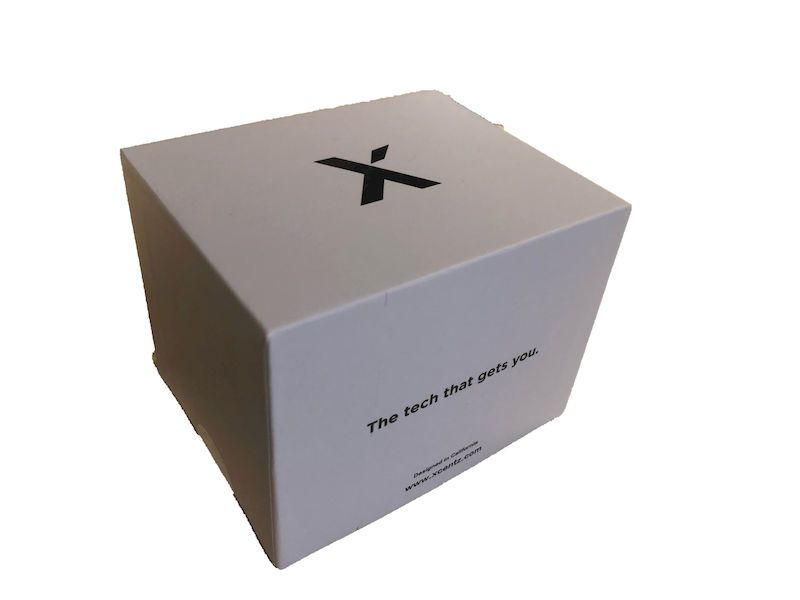
Opening the box reveals the adaptor inside with a warning sticker mounted to the front. 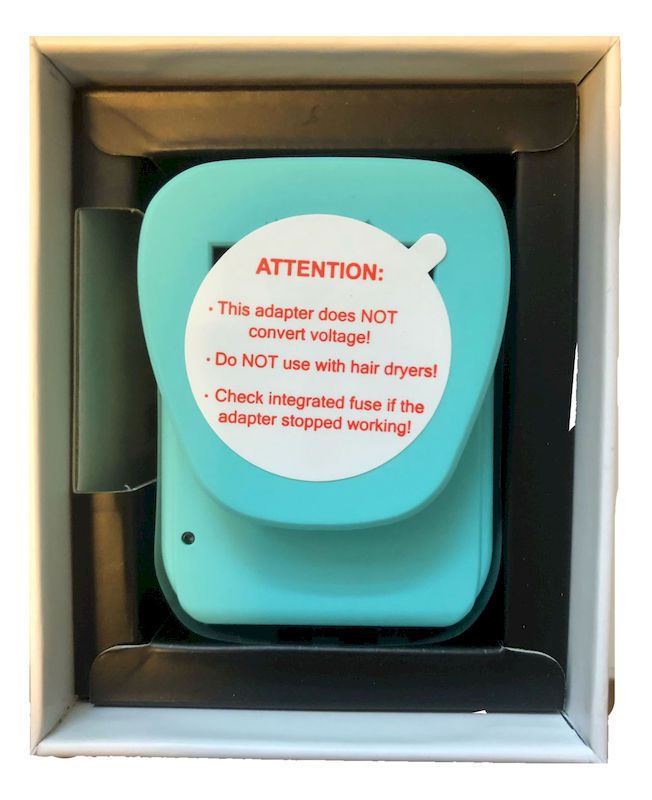 The sticker reads:
The sticker reads:
This adapter does NOT convert voltage.
Do NOT use with hair dryers!
Check integrated fuse if the adapter stopped working.
Design
The Xcentz universal travel adapter is made from a soft touch plastic and is available in pink, cyan, and black. The odd colors seem to me to be the best choices as they seem out of place in a hotel room (except in Key West or the Cote d’Azur) and less likely to be left behind. In the US, the adapter does not block the adjacent outlet on top of a receptacle. Most of the other countries the adapter can plug into have larger spacing between adjacent receptacles.
As described above, the adapter has a two-part design: a part that is an adapter from a Type E or F plug to Type A, B, C, D, E, F, G, I, J, L and N, and the part that is a charger and plugs into Type B, D, E, F, G, H, I, K, and O. The parts connect with a Type F plug/outlet. The two-part design of the unit permits it to be slightly smaller than comparable adapters that use four sliding sets of pins rather than this unit’s three sliding set of pins. However, this design sacrifices the ability to use this adapter as a USB charger and an adapter for plugs other than from countries that support the type C, E, or F plugs. This shortcoming may be overcome if a powerstrip (in the desired outlet specification) is used between the adapter part and the charger part. In the picture below there is another adapter (in grey plastic with a black and red sticker on top) that converts the US plug to a European one. This simulates a European outlet. The cyan adapter part plugs into this and allows me to install a US power strip into the adapter and the charger into the strip. If I plugged the charger directly into the adapter, then the only plug available to me would be the Type F plug at the rear of the charger. I recommend that any traveler bring a powerstrip when staying in locations where there are foreign AC power plugs and sockets. That way one adapter can meet the needs of several electronic devices.
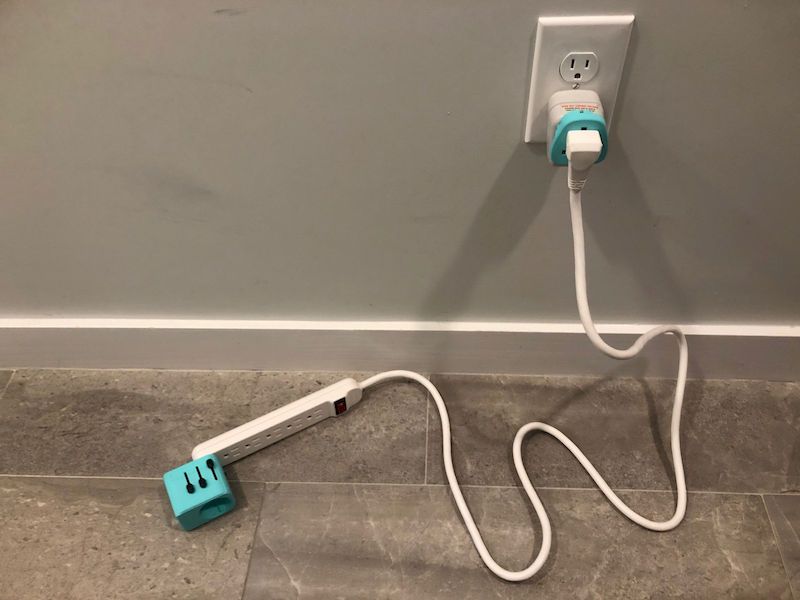
Because the rear of the charger has a built-in Type F outlet, which is symmetrical, the adapter part may be inserted either normally or upside-down to best orient the connected plug. This is convenient in countries where many of the plugs are mounted perpendicular to the cord. However, this also somewhat dangerous, since in this arrangement the live and neutral wires are crisscrossed and anything that is designed with a single throw switch may still be energized while turned off, and any neutral fault will result in an electrocution risk. For safety sake, the adapter part should be inserted into the charger like it is in the picture below in North and Central America and Japan. In other countries, it should be inserted in the opposite direction. Why? Because the adapter slide mechanism reverses the live and neutral on the US plug.
The adapter part has shutters on the pin receptacles to reduce the chance that foreign objects are inserted into an area carrying current. Note that the ground does not have shutters but this is typical. 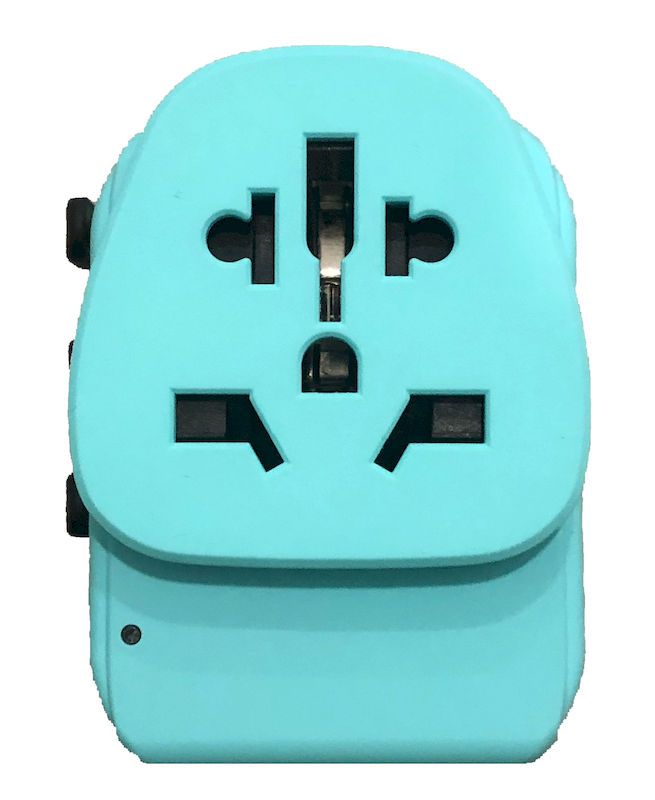 The charger part has shutters on the Type F outlet as well.
The charger part has shutters on the Type F outlet as well. 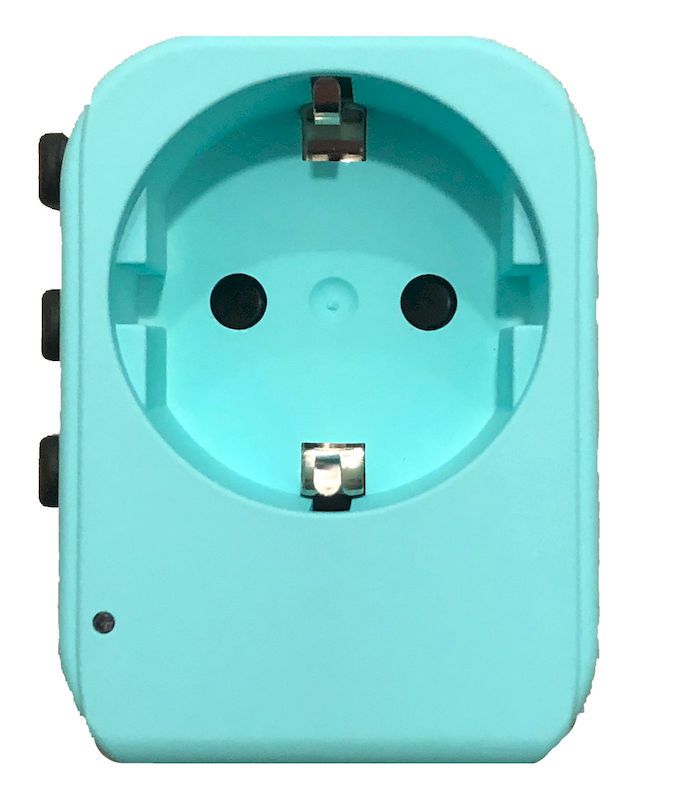 The sliders which extend the selected pins on the charger part are each interlocked so only one set of pins can be exposed at a time. When not in use, all the pins can be retracted into the unit, protecting other things that the unit is packed with from getting jabbed at by the exposed pins.
The sliders which extend the selected pins on the charger part are each interlocked so only one set of pins can be exposed at a time. When not in use, all the pins can be retracted into the unit, protecting other things that the unit is packed with from getting jabbed at by the exposed pins.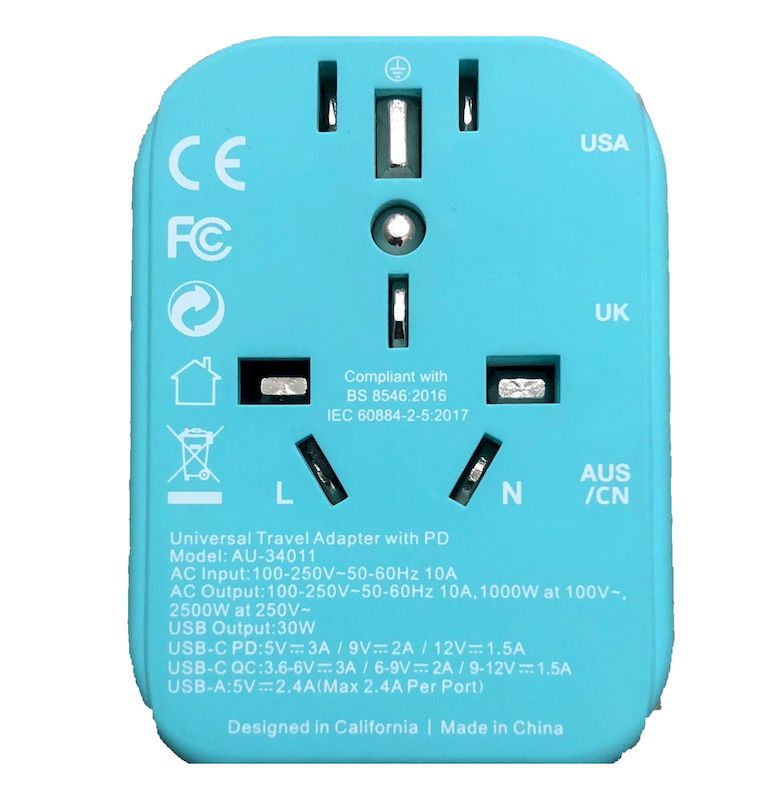
The charger has a dimly lit blue LED to indicate charger power. The ports are located along the bottom so there will be some fishing around for the correct alignment and orientation, but this is more of a shortcoming of the USB-A standard than the adapter. The USB-A ports are 2.4 A max draw and the USB-C port is an 18 W max draw. There is a total of 30 W shared by all of the ports. The USB-C port supports power delivery (PD) but only as a supply. In other words, the charger cannot be run off of power supplied to the PD port.
In order to use the USB-C port, you will need a cable with USB-C on one end or a USB-C to female USB-A adapter. The spacing of the USB-C port is far enough away that a USB-C to female USB-A adapter (or at least the one I have) will not block the adjacent USB-A ports.
The charger also has an overcurrent thermal relay for the AC power. This feature provides peace of mind that the electronics being powered will not cause a hazardous condition. This is important because the charger is rated for 10 A but the EU plug can generally draw 16 A (depending what it is connected to).
Performance
I used the Xcentz universal travel adapter with an iPhone 8, Android (LeEco Le Pro3) with Quick Charge, iPad 9.7″ 6th Gen., J7-t safety tester and a Drok USB intelligent electronic load.
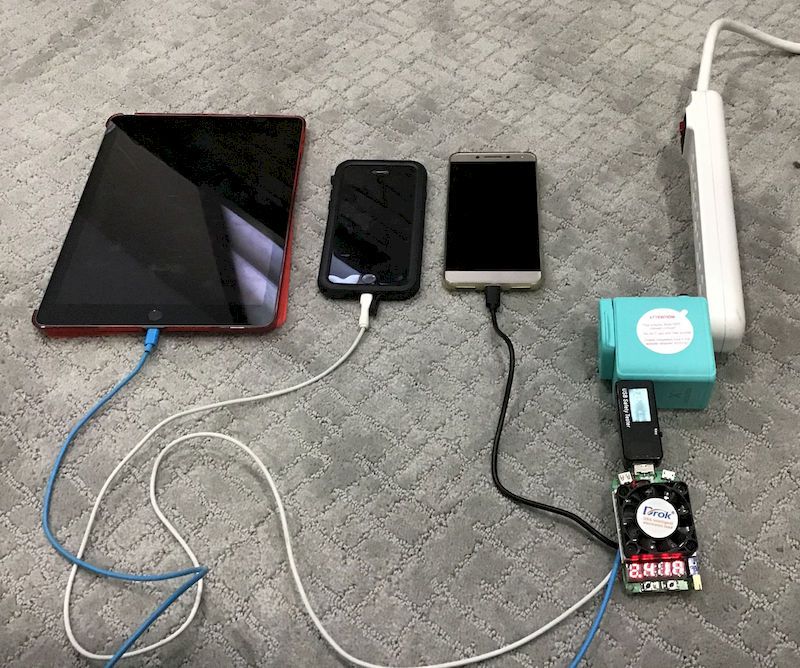
The charger supplied a max of 2.41 A at 4.7 V (11.3 W) to the USB-A ports and up to 15.8 W on the USB-C ports. The USB-C may provide more power but that is all my phone needed at the moment and my simulated load tuckers out at 15.5 W. When two or more items are plugged in the charger tends to load balance across all the loads. When I plugged the LeEco Le Pro into the USB-C the amperage and voltage changed dynamically according to the Quick Charge requirements.
What I like
- includes thermal relay
- state of the art charging options
What needs to be improved
- Adapter and charger usage in European countries needs a powerstrip or similar item
- Adapter part should indicate “TOP USA” and “TOP UK/AUS/CN” so Type F live and neutral wiring is not crisscrossed.
Final thoughts
When traveling, two of the most often needed items are a power adapter and a USB charger. Combining these items into one gadget seems only logical. The device is only slightly larger than comparable devices that include a charger and a pass-through AC outlet. The Xcentz also costs about as much as those other designs but gives the added benefit of world compatibility. I recommend you take this on your next trip.
Price: $29.99. $19.99 with promo code XCENTZS11 through April 20, 2019.
Where to buy: Xcentz
Source: The sample of this product was provided by Xcentz.
Filed in categories: Reviews
Tagged: Batteries and Chargers
Xcentz universal travel adapter review originally appeared on The Gadgeteer on April 8, 2019 at 10:00 am.
Note: If you are subscribed to this feed through FeedBurner, please switch to our native feed URL http://the-gadgeteer.com/feed/ in order to ensure continuous delivery.
